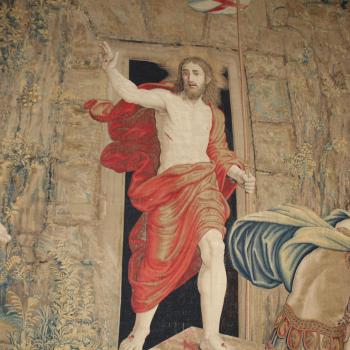The Adventurous Lectionary – Easter Sunday – April 12, 2020
Acts 10:34-43
Psalm 118:1-2, 14-24
Colossians 3:1-4
John 20:1-18
Matthew 28:1-10
Just the other day, a fellow pastor noted, “I just can’t get into the Easter spirit this year. We’ve canceled everything public from our sunrise service to the sanctuary services and the Easter egg hunt. Online worship just doesn’t cut it for me.” I am sure that this pastor’s feelings are echoed by scores of other pastors and thousands of congregants, many of whom are now scrambling to get the traditional Easter ham and chocolate bunnies! Certainly, if we imagine Easter in pre-pandemic American style – new clothes, big dinners, egg hunts, and stylish hats, Easter will be a loss this year. Still we must tell the story of death and life, of cross and resurrection, and if we let go of our previous images of Easter, we may come to see this year’s Easter in a more authentic, transformative light.
The Easter stories overwhelm the linear, rational mind. They confound our fears and sense of loss and hold out hope in the most desperate times. A risen Jesus, a revived and energized corpse, angelic visitors, and death emerging long after the cessation of brain activity – how can such things be? No wonder we find it easier to celebrate the day with chocolates, Easter eggs, new clothes, and hats. These all come from the realm of predictability, while Easter turns everything upside down. But now everything is upside down, and we need a real not faux resurrection.
As a preacher, there are times I wander what I can possibly preach on Easter. But, perhaps, this year, preaching Easter in a time of pandemic will seem authentic and inspiring. A literal Easter story is far too supernatural and surprisingly too wooden, even in a quantum universe. Conversely, the minimalist approach by the Jesus Seminar and some New Testament scholars is far too one-dimensional. No one risks their lives, as the first followers of Jesus did, over a fabricated story and a localized rotting corpse.
Easter surely participates in the interplay of kataphatic and apophatic spirituality: we have to shout it from the rooftops, “Christ the Lord is Risen today!” even as we equally confess that the stories are shrouded in mystery, and that whatever radical event occurred is far beyond our comprehension. Still, amid all the mystery and incomprehensibility, we need a resurrection, a testimony to life in the face of death! We need an image of hope sequestered as we are in our homes this Easter. Pastors fumbling with Facebook live and Zoom need inspiration and a sense of divine transformation.
A companion of the Risen Jesus, Peter claims the resurrection is a universal reality, transforming history backward and forward. (Acts 10:34-43) All humankind shares in the power of the Risen Christ; its impact transcends all boundaries. Peter preaches about what he has seen and heard, but surely can’t fully grasp: Jesus is appointed and anointed and resurrected. The flesh and blood Jew Paul came to know as Savior has special place in God’s global vision of salvation. His resurrection reflects the same reality present in his healing and teaching; his liberation of the oppressed is magnified through resurrection, for with resurrection power he liberates all creation. All who believe in Christ’s mission receive resurrection spirit: the forgiveness of sin and power from heaven. Opening to the risen Christ awakens us to new possibilities; to new life; and to transformation where death was all around. Where will we find resurrection and new life in a pandemic-saturated world?
Psalm 118 proclaims that this is the day that God has made – the day of new life and salvation – and we shall rejoice and be glad in it. Resurrection leads to celebration and joy. God’s love is faithful and enduring and can bring new life out of death-filled situations. This is my mantra as I awaken each day: I woke up and in the hours that lie ahead, how will I embody new life? How will I be a faithful pastor, parent, grandparent, and friend? How will I be a hope giver as I face my own fears? (For more on spirituality related to COVID-19 see Bruce Epperly, FAITH IN A TIME OF PANDEMIC.)
Colossians 3 describes the life-transforming impact of the Risen Christ. All who believe are transformed. Resurrection opens us to new dimensions of life and challenges us to live as resurrection people; being both heavenly minded and earthly good. We share in God’s glory, in resurrection glory; and we are living in Christ’s resurrection reality. Resurrection is a present reality, stretching into the infinite future.
The Gospel of John depicts two resurrection moments: the first describes the reality of the empty tomb. The disciples view the empty tomb and go home without any fanfare. The quiet perplexity of the disciples raises the questions: What did they think was going on when they encountered the empty tomb? Did they understand its emptiness to be a sign of resurrection? What did they do when they returned home? Did they notice Mary of Magdala crying in the garden?
The second resurrection moment: Mary of Magdala’s encounter with Jesus is truly intimate and personal. She doesn’t know that Jesus is risen; all she knows his that the tomb is empty and his body gone. She fears, we might suspect, that his body has been hidden by his persecutors. Frantic, she asks the gardener. But, then he speaks to her, calling her by name, and she knows it is Jesus. She tries to hold onto him, but Jesus doesn’t want her to hold onto him. He is not rejecting her, but opening her to new possibilities for understanding his post-resurrection mission. Still, Jesus’ response leaves us with questions: Is his body in process, becoming some form of heightened energy? Or, does he want her to see him as non-local as well as local, no longer bound by time, place, or persona?
Matthew’s Gospel presents an alternative story. A group of women, along with Mary of Magdala come to the tomb and find it to be empty. Instead, they encounter a divine messenger who commissions them as Gospel messengers. On the way to deliver their improbable and world-shattering news, they encounter the risen Jesus who gives them a similar commission, “Don’t be afraid. God and tell my brothers to go to Galilee, there they will see me.” Sheltering in place, how do we “go” to our Galilees, sharing news of resurrection?
Both Gospels place women front and center in sharing the good news of resurrection. They see the transformed Jesus, whereas the disciples only see hints of resurrection. They receive the first “great commission.” They believe the impossible, not because of the testimony of others, but as a result of their own experience. Perhaps that is our situation living in a time of pandemic as well: the resurrection stories drive us beyond the rational – they give us images of hope, realistic hope in a death-filled world, such that the only proof of resurrection must be experiential – our own experience of surprising new life when death appeared to be victorious.
A rabbi friend often quotes Martin Buber as saying, “reality is not always understandable, but it is embraceable.” It is a fool’s quest – and an act of hubris – to “understand” the resurrection; but we can “embrace” it experientially and imaginatively, opening to dimensions undreamed of in God’s surprising and ever-creative providence. It is a fool’s quest to control either resurrection or the coronavirus. We need a resurrection, and only a surprising, non-linear, not fully understandable and hope-giving revelation, can save us.
+++
Bruce Epperly is a Cape Cod pastor, professor, and author of over fifty books including FAITH IN A TIME OF PANDEMIC, GOD ONLINE: A MYSTIC’S GUIDE TO THE INTERNET, and PROCESS THEOLOGY: EMBRACING ADVENTURE WITH GOD.












